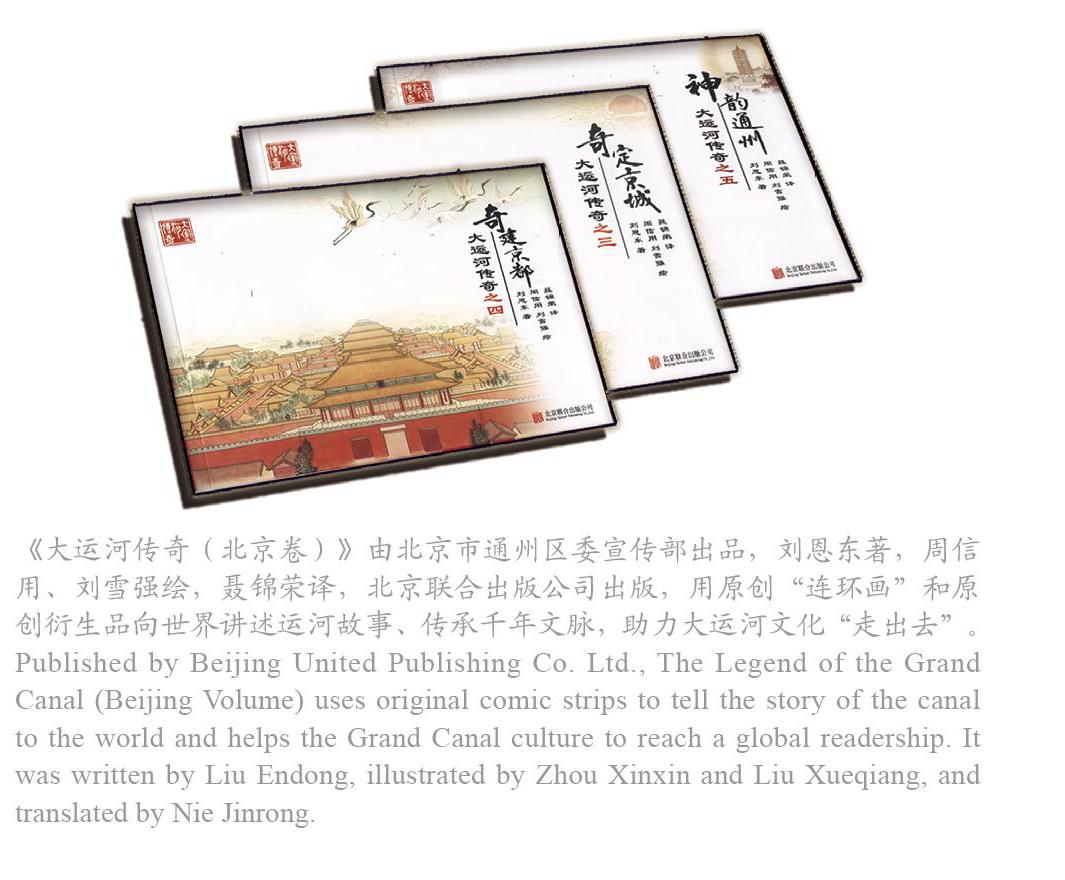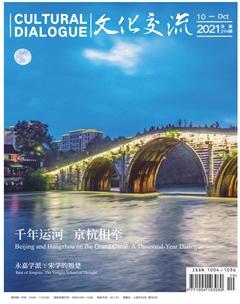运河文化走向世界
马克强


近日,两名从欧洲来中国杭州旅游的年轻人,凭着一张意大利报纸上的三孔石拱桥照片,一路寻觅至标有“京杭大运河南端”的石碑前,一睹千年运河上这座名叫“拱宸桥”的老石拱桥的风采。
今年以来,在中国大运河位于拱墅区30多公里长的遗产河道上,一批运河文化地标正在陆续“上新”,杭州市拱墅区全面打造的运河大剧院、运河中央公园、上塘古运河夜游等20个文化地标已开放6处,大部分将于明年亚运会前亮相。
在北京市通州区城市绿心森林公园里,50支骑行队伍的400余名骑行爱好者共同参加了2021年“世界无车日”全民健身健康骑行月活动。在此之前的北京市大运河国际交流季上,相关中外专家学者以这场跨越南北的大运河对话为契机,为运河沿线自然、生态等方面的发展出谋划策。
一个个镜头、一幅幅画面,定格了“保护好、传承好、利用好”大运河文化的城市故事。这既是日常,更是2021年“中国大运河文化带京杭对话”活动的预热和深化。今年,第三届“中国大运河文化带京杭对话”将在杭州举行,这一跨越千里的牵手,将再次出发,京杭两地将共同守护中華文明的“精神密码”、共同当好历史文化遗产的“薪火传人”、共同谱写运河开发利用的“精彩范式”。
京韵流芳:一直进取 责无旁贷
2017年,北京成立推进全国文化中心建设领导小组。在此基础上,包含大运河文化带建设组在内的8个专项工作组成立。此后,重点文物腾退、文物保护修缮、重大公共文化设施建设、历史风貌恢复等工作扎实推进,北京正努力走出一条传承弘扬运河文化的特色之路。
大运河北京段共有现存遗产资源40处,运河文化深深嵌入水道、码头、仓场、闸坝、官署等各处。到通州区北运河源头瞧瞧1400多年历史的燃灯佛舍利塔,运河古韵扑面而来;再看看东四十条600岁的南新仓,这座全国仅有的皇家仓廒,漕运文化被展现得淋漓尽致。
运河水的灵秀滋养着运河两岸人们的生活,形成了一大批具有浓郁地区特色的非物质文化遗产。据北京市文化部门统计,大运河北京段所涉6个区共有国家级非遗代表性项目86项,市级非遗代表性项目107项,运河的文化符号生长在了北京的各个角落。
去年,大运河沿线8省市文化厅(局)在京共同主办大运河文化带非遗大展暨第四届京津冀非遗联展,汇聚近3000件非遗精品。大展以“流动的文化”为主题,通过见人、见物、见生活的非遗精品折射运河文化的魅力。此外,北京市还持续开展“我身边的运河故事”征集工作,同时在北京市方志馆的京华讲坛开设了中国大运河历史文化讲座。
通州是北京运河文化遗产分布最集中、最丰富的地区,它的规划建设结合大运河文化带的保护建设,彰显蓝绿交织、水城共融的城市特色,打造运河博物馆、路县故城遗址博物馆等文化设施,让大运河文化带成为北京城市副中心的标志性文化品牌。
通州区还挖掘历史文化,编辑出版《大运河文化带 · 通州故事丛书》,从通州水系、漕运码头、运河民俗等方面讲述通州与大运河的故事。在大运河文化带建设中,通州区形成了“一线四区多点”的文物保护格局,即以保护大运河为主线,打造通州古城、张家湾古城、漷县古城、路县故城遗址“四大片区”,挖掘多点遗存,彰显运河文化底蕴。
保护之外,如何让大运河浸润如今人们的生活?其精髓在于结合,一是把不可移动的运河文化遗存和传统技艺、非物质文化遗产相融合,满足群众多元化需求,促进文化消费;二是把文化和旅游相结合,目前通州区的重点放在了“三庙一塔”景区,不断完善旅游服务业的硬件条件。
故宫博物院原院长单霁翔表示,大运河蕴含着丰厚的传统文化遗产和驱动国家“一直进取”的文化基因,让文化遗产“活起来”,华夏儿女责无旁贷。
目前,北京正带头落实《大运河文化保护传承利用规划纲要》,真正使大运河文化带成为北京建设全国文化中心的示范工程、满足人民群众日益增长的多样化精神文化需求的民心工程、建设国际一流的和谐宜居之都的标志工程。
杭城盛放:乐享惠民 文化盛宴
杭州是京杭大运河的南端,若想体验感知中国大运河文化,位于杭州拱墅区、大运河之南的拱宸桥提供了一种适宜的观察视角。
“船由沪来,先经拱宸,过省城,乃达江干,深入内地。”如《清季外交史料》中所言,1908年以前,拱宸桥是经运河北上沪、苏、宁、津、京等地的必经之路,也是自北入杭的要隘。如今,拱宸桥边,老厂房、旧仓库改建而成的博物馆里,文化活动和互动体验精彩不断。
“扇动风发——杭州雅扇文化月”活动期间,一场扇文化主题表演在中国扇博物馆举行,复原传统的绘画、书法、烙烫等制扇场景,汉服、古琴、书画与团扇等元素共同演绎“中国扇子”的前世今生。
“与工艺美术大师面对面”活动中,杭州工艺美术博物馆的大师工作室最近推出的西湖绸伞、皮影、麦秆剪贴扇、陶瓷捏塑、剪纸等手工艺体验项目,格外受青少年观众和国外游客的欢迎。
运河两岸不独戏曲声悠扬,歌声、乐声、欢笑声亦长年不断。仅据拱墅区的统计,运河边的群众文体活动团队就有380多个,常态化举办诗歌吟咏、挥毫泼墨、吹拉弹唱等文化活动和展示。
与其他单一古建筑、古遗址的保护不同,大运河是仍在流淌、仍在使用的“活态文化遗产带”,更需要活化的保护、传承和利用。
《大运河文化保护传承利用规划纲要》提出,深入挖掘和丰富大运河文化内涵,充分展现大运河遗存承载的文化,活化大运河流淌伴生的文化,弘扬大运河历史凝练的文化。
为此,拱墅区当前正在高标准推进大运河文化带拱墅段建设,各级各部门深入学习贯彻浙江省委文化工作会议精神,聚力抓研究、抓传播、抓转化,以高质量供给服务高品质生活,努力让运河真正成为人民和游客的运河。
拱墅区正把运河文化的活化保护和开发利用结合起来,以大运河文化带建设为主线,谋划“拱墅区大运河文化资源分布图”,开展“拱墅区建设大运河国家文化公园样板区”课题研究,推动文旅融合地标建设。今年7月开始试运营的《如梦上塘》夜游项目,就是以创新形式保护与展示上塘河遗产河道、重现古运河繁华、让市民游客乐享惠民“文化盛宴”。
當前,依托运河两岸已有的博物馆、工业遗存等,拱墅区正在打造“全域没有围墙的博物馆”,同时以社区为单位打造“运河书房”“微博物馆”等170余处公共文化设施,把运河元素积极融入社区文化家园、杭州书房等基层文化阵地建设,全域构建10分钟文化生活圈。拱墅区相关部门负责人表示,接下来拱墅区还将进一步提高大运河文化带相关设施的普惠面,让文化更加深度融入群众生活。
作为中国大运河文化带经典案例之一,杭州是大运河文化带建设的先行者之一。早在2017年,经过世界休闲组织评审委员会的评审,杭州“桥西历史街区综保工程:棚户区到休闲遗产高地的蜕变”项目,从全球10多个国家30多个项目中脱颖而出,摘得2017世界休闲组织国际创新奖。通过运河主城区段对老城区的改造,让运河沿线老城区和周边的新城区融合共赢,这也成了运河沿岸城市综合保护利用的典范。
携手世界:运河文化 熠熠生辉
京杭两地在中国大运河文化带建设领域各有特色,即将在杭州启幕的2021“中国大运河文化带京杭对话”,不仅是一场横跨千里、纵跨千年的对话,更是运河沿线城市携手推动运河文化保护、传承、利用的一项创举。
连续三年举办“京杭对话”,标志着运河沿线城市将共下“一盘棋”,携手“齐步走”,以文化为引领促进各区域协调发展,其示范效应明显。
保护大运河就是保护绵延千年的文化基因。穿越古今,沟通中国。
从古代到当代,能够“读懂”大运河的不仅仅只是中国人。据悉,全球50多个国家和地区分布着520条运河,沿线近3000座城市有着类似的运河记忆,也面临着类似的挑战与机遇。
2014年,中国大运河申遗成功后,歌剧《运之河》从瑞士日内瓦开启了国际巡演之旅,沿途受到世界各国观众的欢迎。该剧以大运河的开掘、通航为经,以隋、唐的朝代更迭为纬,呈现大运河赋予家国命运的现实思索。瑞士著名音乐家克伊奈·米歇尔看完歌剧后评价道:“《运之河》用歌剧艺术的形式呈现大运河贯通南北的开凿历史,虽然讲的是中国的历史故事,但采用现代音乐的表达形式,欧洲人会从这样的演出中进一步感知中国。”
“以运河为联系纽带,结成全球运河共同体,为可持续发展寻找世界级的答案。”在内河航道国际组织主席大卫 · 爱德华兹 · 梅看来,这正是运河申遗的意义所在。
近十年来,世界各国驻华使节、运河管理者和专家学者共商、共建、共享运河保护与发展的探索与经验。到今年,合作组织的会员已经从最初的13个发展到153个,其中国外城市会员46个,遍及五大洲。
文明因交流而多彩,文明因互鉴而丰富。在不断扩大的中国大运河文化带“朋友圈”里,京杭两地正用世界语言讲述运河保护的城市故事、中国智慧,让大运河这张金名片在世界舞台上更加熠熠生辉。
深秋的杭州,层林尽染,水碧天蓝。城市北部的拱宸桥历史文化区内,京杭大运河博物馆向市民讲述着大运河的底蕴和纹理。未来,这里将成为中国大运河的全线新地标,不仅留存于博物馆、历史遗迹和人们的记忆中,更鲜亮地活在当下。
(本栏目由中国新闻社浙江分社提供支持)
The Great Canal Culture Goes Global
By Ma Keqiang
A couple of young tourists from Europe visited Hangzhou simply because they had seen a photo of a three-hole stone arch bridge in an Italian newspaper. With it, they went all the way to the stone stele marked the “Southern End of the Jing-Hang Grand Canal”, just to get a glimpse of the ancient Gongchen Bridge, the three-hole stone arch bridge in their photo, on the thousand-year-old canal.
Along the 30-odd-kilometer section of the Grand Canal in Hangzhous Gongshu district, six out of 20 cultural landmarks, including the Grand Canal Theater and the Grand Canal Central Park, have been opened to the public in 2021, with the rest expected to be unveiled before the 2022 Hangzhou Asian Games.
In the Central Green Forest Park in Beijings Tongzhou district, more than 400 cycling enthusiasts from 50 cycling teams gathered for the 2021 “World Car Free Day” in the buildup to the 2021 “Beijing Hangzhou Dialogue on the Grand Canal”. Just a couple of months ago, experts and scholars from China and abroad met in Beijing in an international forum to discuss the environmental development along the Grand Canal.
These are only a few snippets of the “daily life” for the protection and inheritance of the Grand Canal. In fact, the 2021 “Beijing Hangzhou Dialogue on the Grand Canal”, held in Hangzhou this time, will further explore new ways and models to better preserve the cultural heritage of the Grand Canal.
In 2017, a leading group promoting the establishment of national cultural center was set up in Beijing, based on which, eight special working groups, including the one on the construction of the Grand Canal Cultural Belt, were also set up. From then on, Beijing has gone from strength to strength in evacuating key cultural relics, protecting and repairing cultural relics, developing major public cultural facilities and restoring historical features.
Along the Grand Canal Beijing section, some 40 heritage sites can be found, and the canal culture is deeply embedded in waterways, wharfs, warehouses, dams and ancient official offices residences. The 1,400-year-old Randengfo Sheli Pagoda standing at the start of the Bei (North) Canal in Tongzhou district and the 600-year-old Nanxin Granary at Dongsi Shitiao in Dongcheng district are just two cases in point. According to statistics, the six districts that the Beijing section of the Grand Canal goes through boasts of 86 national representative intangible cultural heritage projects and 107 municipal representative intangible cultural heritage projects. The cultural symbols of the Grand Canal permeate every corner of Beijing.
Beijing is now taking the lead in implementing the Outline of the Plan for the Protection, Inheritance and Utilization of the Grand Canal Culture. The city aims to make the Grand Canal Cultural Belt a demonstration project in the process of building Beijing into a national cultural center, a popular project to meet the growing needs of the people and a marquee project in the process of building Beijing into a world-class harmonious and livable city.
In 2020, an exhibition, its fourth edition, with nearly 3,000 pieces of exhibits showcasing the intangible cultural heritage along the Grand Canal was held in Beijing. In addition, “Canal Stories around Me”, a campaign to collect real life stories on the Grand Canal, has continued to attract popular support, and lectures on the history and culture of the Grand Canal were also held.
As the area where the canal cultural heritage resources are most concentrated in Beijing, Tongzhou district is carrying out a series of related projects. It is planning to establish a museum on the Grand Canal as well as an archeological museum on the site of the ancient Lu county and other cultural facilities. It has also published “The Cultural Belt of the Grand Canal: Tongzhou Story Series”, presenting the Tongzhou story through its waterways, Caoyun Dock and canal folk customs.
Shan Jixiang, former director of the Palace Museum, said that the Grand Canal contains rich traditional cultural heritage and the cultural genes that drive the country to “forge ahead”, and it is the responsibility of the Chinese people to make the cultural heritage “come alive”.
Indeed, in addition to protection, how better to let the Grand Canal “walk” into peoples everyday life? One is to integrate the immovable canal cultural heritage with traditional skills and intangible cultural heritage to meet the diversified needs of the public and promote cultural consumption. Another is to combine culture and tourism.
In Hangzhous Gongshu district, where Gongchen Bridge, the southern starting point of the Grand Canal lies, various initiatives have been proposed and taken. “Boats coming from Shanghai will pass Gongchen first, then the provincial capital, before reaching Jianggan and travel further deep into the inland,” a late-Qing document recorded. While the bridge used to be a point that one must go through to travel to Shanghai, Suzhou, Nanjing, Tianjin and Beijing via the Grand Canal, it and the surrounding area now make a vibrant cultural block.
Old factory and warehouse have been converted into museums, where cultural activities and interactive experiences take place on a daily basis. During the “Hangzhou Fan Cultural Month”, for instance, fan culture-themed performances have been held to replicate the traditional fan-making process. In “Face to Face with the Master of Arts and Crafts”, an interactive event launched by the Hangzhou Arts and Crafts Museum recently, visitors are able to try their hands on making the West Lake silk umbrella, playing puppet shows, creating pottery and doing papercutting, among others.
On both sides of the Grand Canal, melodious operas, singing, music and laughter can always be heard. Statistics from the Gongshu district show that self-organized cultural and sports groups active along the canal are numbered at more than 380, which regularly organize poetry recital, calligraphy, painting, musical instrument playing, singing and assorted cultural activities.
Beijing and Hangzhou have their own unique characteristics in the building of the Grand Canal Cultural Belt. The 2021 Dialogue on the Grand Canal, which will be held in Hangzhou, Zhejiang province, is not only a dialogue “crossing thousands of miles and spanning thousands of years”, but also a pioneering initiative for cities along the canal to jointly promote the protection, inheritance and utilization of the canal culture.
Figures indicate that there are 520 canals in more than 50 countries and regions around the world, and nearly 3,000 cities along these canals have similar “memories of canal” as the Chinese cities along the Grand Canal, and face similar challenges and opportunities.
“With the canals serving as the link, a global canal community should be formed, so that we can find answers to sustainable development that are applicable to the entire world,” this, according to David Edwards-May, president of Inland Waterways International, is the ultimate point.

